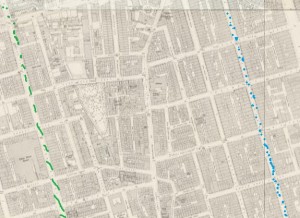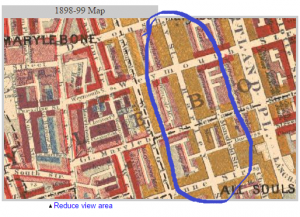Harley Street and Baker Street on OS map of London from 1893-96 (Harley Street in blue)
“Our footfalls rang out crisply and loudly as we swung through the doctors’ quarter, Wimpole Street, Harley Street.. , and so through Wigmore Street into Oxford Street. In a quarter of an hour we were in Bloomsbury at the Alpha Inn, which is …which runs down into Holborn”.
Sherlock holmes and Watson in the story The Blue Carbuncle walk through the streets of London on their way to the Alpha Inn to follow up a lead into the case of the stolen blue carbuncles. Harley Street is parallel to Baker street (see on OS map above), and not far so the route, they walked through in the story, makes sense. However, when following this route on the map it does not match up. Harley Street does not meet with Wigmore on the way to Holborn, as can be seen on the OS map of London from 1869-80 below.
Red line- Baker Street, Yellow line- Wimpole Street, Green line- Harley Street, Blue line- Wigmore Street, Purple dotted line- the route Holmes took. The end of the blue line is where Wigmore Street ends, Cavendish Square begins. Harley flows into Cavendish Square.
In the story they walk from Harley Street to Wigmore Street which is possible only if they turn counter to their next destination Oxford Street towards Holborn. The point is that Conan Doyle wanted to include Harley and Wimpole streets in the story even if it doesn’t make sense for them to walk that way, especially when in a rush in a very cold night.
Harley Street is specified in the story as the doctors’ quarter. it was, and still is, regarded as the quarter of the best doctors:
“White Mason gazed at my friend as the little village practitioner looks at the Harley Street specialist who by a word can solve the difficulties that perplex him” (the Valley of Fear Chapter 4 ).
Harley Street is also discussed in the story The Resident Patient:
” In March of that year Dr. Moore Agar, of Harley Street … gave positive injunctions that the famous private agent lay aside all his cases and surrender himself to complete rest if he wished to avert an absolute breakdown.”
Here again a Harley Street doctor is mentioned as an indication to a high quality care given to Sherlock Holmes.
The map in Charles Booth Poverty map shows that Harley street residents were from Upper-middle and Upper classes, Wealthy.
Baker Street residents, according to Booth Poverty Map are designated in red- middle class, Well-to-do . So Harley Street residents were considered of a higher class then those on Baker Street.
Walter Thornbury in his book Old and New London: Volume 2 supports the portrayal of Harley street: “The doctors now swarm in Cavendish Square, Harley Street, Wimpole Street….” referring to the migration of practitioners from Finsbury Park area to the Harley street area in mid 19th century. He continues: “When the doctors and surgeons thus swarmed in the Finsbury district, the City and its adjacent districts were largely inhabited by wealthy families, that have now also migrated westward, as their doctors naturally have.
Sherlock Holmes in his walks in upper class districts, and in him being treated by upper class doctors maybe positioned as a close member to the upper classes. In the British class based society this position might be necessary to shape Holmes’ character as respected and trusted.



